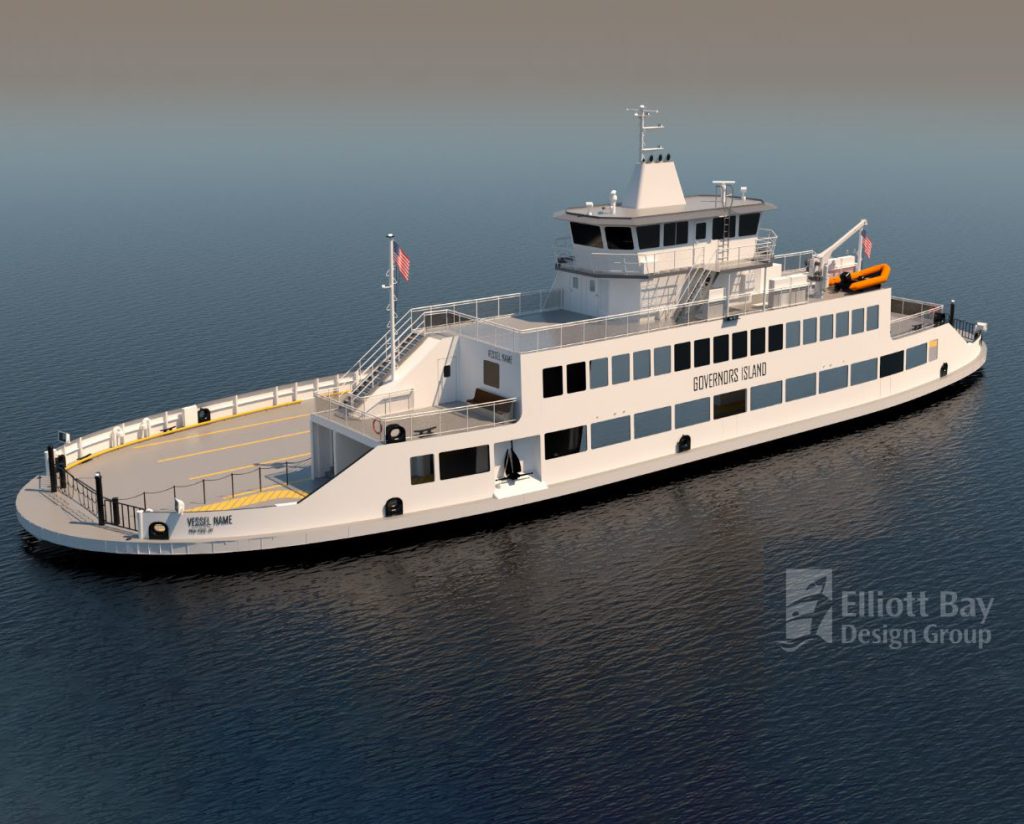
CEO Spotlight: John Waterhouse, founder & principal of Elliott Bay Design Group
Written by Heather Ervin
New vessel is on track to be first battery-hybrid ferry to operate in New York Harbor. (Credit: EBDG)
Elliott Bay Design Group (EBDG) has been involved with numerous cutting-edge vessel designs. Many of these have had a green focus.
The Seattle-based naval architecture, marine and electrical engineering company provides its services to vessel owners, operators and shipyards across the country.
In this Q&A, we talk to John Waterhouse, founder and principal of EBDG with over 40 years of industry experience, about the green efforts taking place in vessel design over the last year and how those efforts will expand into the future.
Marine Log (ML): Can you tell us more about EBDG’s involvement with perhaps one of the more recent vessel designs, the first-ever methanol-fueled towboat, the Hydrogen One, and EBDG’s role in this project?

John Waterhouse (JW): EBDG is pleased to be working with our teammates, Maritime Partners, e1 Marine, and ABB on this innovative project. EBDG’s role has been to take the technology developed by e1 and ABB and fit it into a vessel.
As described by one of our principals, Mike Complita: “Our naval architects have optimized the balance between reformers, fuel cells and batteries to maximize range and power while minimizing operational costs.”
Peak power output from the propulsion system will be 2,700 hp. making this vessel suitable for a fleeting operation or handling barges on smaller rivers. The technology is scalable, so there is no reason it couldn’t be applied to vessels of the Upper Mississippi River or Ohio River, where conventional vessels require 3,000 to 4,000 hp.
ML: EBDG has worked on several hybrid-electric and diesel-battery hybrid passenger vessel designs in recent years. Do you see this trending into future and what has changed in the world of hybrid vessels over the last few years?
JW: We certainly believe that battery hybrid will have lots of future applications to passenger vessels, workboats, and possibly even some fishing vessels. The key is to examine each application with an open mind. There is no magical solution that will work on all vessels! The challenge is to understand how energy is used over time and when there are opportunities for recharging that energy. Every operation will have a different answer. EBDG can help operators look at their fleets and identify which types of technology make sense for them.
The big trends we are seeing is the reduced cost per kilowatt hour for batteries and there are new battery chemistries that may provide better power density at a lower cost than today’s lithium-ion types. The other big trend is that more manufacturers are getting product into the market so our clients will have more vendors to choose from.
ML: Of these hybrid passenger vessel projects, which presented your team with the most challenges and how did EBDG meet those hurdles?
JW: Each project has brought its own challenges so the EBDG team is always learning. Two lessons that may help others are as follows: 1) all electrical equipment produces some heat, regardless of the efficiency of the gear. Cooling systems are vital for keeping motors, batteries, and switchgear operating. 2) There is more electrical cabling than you think. Not just power cables but control and data cables connect everything together. This cabling needs careful attention as you lay out equipment and plan for cableways, bulkhead penetrations, electromagnetic interference, and future needs.
ML: EBDG worked on a concept design of a fuel cell powered high-speed foot ferry. Can you tell us more about this project and its green attributes?
JW: To best serve our clients, we need to understand how new technologies will impact a design. Low-emission vessels require additional equipment to reduce their environmental performance. This equipment adds weight, takes space, increases the capital cost, and must be maintained. It must also comply with safety regulations, which also impact the placement of equipment and may constrain some of the operations. The EBDG team needs to be informed on these issues so we can knowledgably advise our client.
We took the design of a high-speed catamaran ferry that was developed by our partners at AMD Marine Consulting for the Water Emergency Transportation Authority (WETA) in the San Francisco Bay Area. This vessel, the PYXIS, has conventional diesel engines with selective catalytic reduction (EPA Tier 4) and waterjet propulsion.
The vessel carries up to 445 passengers at 34 knots on a route from Vallejo to San Francisco.
We wanted to understand the impacts on design and cost if we were to shift to a zero-emission propulsion system using hydrogen fuel and fuel cells to power electric motors to drive the waterjets. Our goal was to keep the same performance of 445 passengers at 34 knots. The resulting design had a lightship weight increase of 63 MT, a beam increase of 1.25 meters, and a length increase of 4.5 meters.
The hydrogen fuel was stored as a compressed gas with sufficient volume for two round trips per day plus a 25% margin. Initial estimates showed that the zero-emission vessel would be approximately 2.5 times the cost of the smaller conventional design. Getting to zero emissions is not cost-free!
ML: Finally, can you tell us what the marine industry can expect from EBDG in terms of partnering on future green vessel projects and why (or if) you believe it’s important to do so?
JW: The EBDG team is committed to helping our clients build or convert vessels to achieve lower environmental impacts. As noted above, there is no magic solution so we as an industry must be looking at all types of alternative fuels, innovative technologies, energy reduction measures, and energy storage systems.




